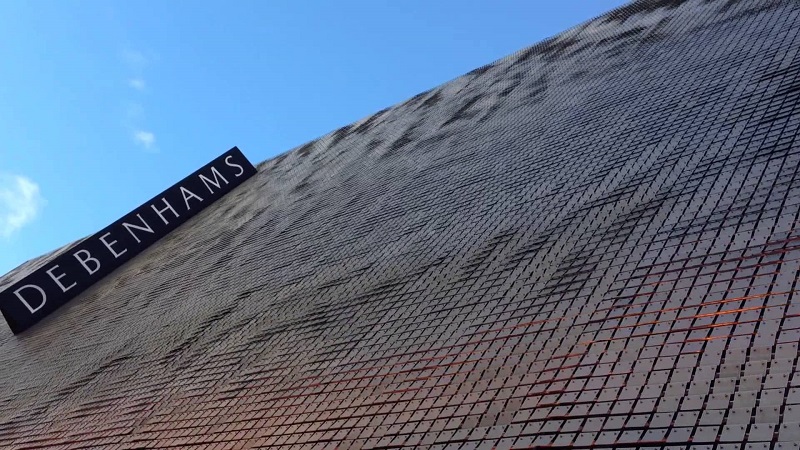Kinetic facade
A kinetic façade is one that changes dynamically rather than being static or fixed, allowing movement to occur on a building’s surface. This helps to create what the architect Buckminster Fuller called a ‘skin-like articulation’ effect, and is an extension of the idea that a building's envelope is an active system rather than just a container.
A kinetic façade can be used to manage light, air, energy, and even information. They can act to reduce solar gain as well as allowing the passage of fresh air into the building, helping to alter the interior environment. The moving elements of the façade can be programmed to respond to climatic or other environmental factors, time, levels and type of occupancy and so on to improve performance and efficiency.
With advances in sensors, materials and building management technology, designers are increasingly able to consider kinetic components as design solutions.
The Al Bahr Towers in Abu Dhabi has a computer-controlled facade made of umbrella-like panels. These panels open and close throughout the day in response to the sun’s movement, giving optimal shading and allowing light to enter the building as required.
The Berlin-based design studio WHITEvoid developed FLARE in 2008. This is a kinetic ambient reflection membrane, meaning that a building could have a ‘living skin’, enabling the façade to breathe in response to the environment. Stainless steel flakes tilted by pneumatic cylinders act to reflect natural light away from the building, maintaining a comfortable interior environment during hot weather.
Built for Expo 2012, the Theme Pavilion EXPO in South Korea, ‘breathes’ through the façade’s biomimicry. Synchronised actuators move 108 kinetic lamellas which are powered by solar panels.
Kinetic facades can also be used for aesthetic purposes, to make a strong impression, to generate interest, or as part of art exhibitions.
The 2014 refurbishment of the Oxford Street Debenhams store (see top image). Designed by Archial Architects, included a cladding screen made up of 185,000 aluminium shingles which can move independently with the flow of wind to create a fluid or ripple effect across the entire surface, as well as providing some protection against rain.
[edit] Related articles on Designing Buildings Wiki
- Biomimicry.
- Building fabric.
- Cladding for buildings.
- Curtain wall systems.
- Dynamic façade.
- Fabrik by Shildan.
- Façade retention.
- Glazing.
- Large-scale murals.
- Living façade.
- Pebbledash.
- Rustication.
- Schuppen house.
- The development of structural membranes.
- Wall types.
[edit] External resources
- DE Magazine - Why kinetic architecture is more than a spectacle
Featured articles and news
A change to adoptive architecture
Effects of global weather warming on architectural detailing, material choice and human interaction.
How big is the problem and what can we do to mitigate the effects?
Overheating guidance and tools for building designers
A number of cool guides to help with the heat.
The UK's Modern Industrial Strategy: A 10 year plan
Previous consultation criticism, current key elements and general support with some persisting reservations.
Building Safety Regulator reforms
New roles, new staff and a new fast track service pave the way for a single construction regulator.
Architectural Technologist CPDs and Communications
CIAT CPD… and how you can do it!
Cooling centres and cool spaces
Managing extreme heat in cities by directing the public to places for heat stress relief and water sources.
Winter gardens: A brief history and warm variations
Extending the season with glass in different forms and terms.
Restoring Great Yarmouth's Winter Gardens
Transforming one of the least sustainable constructions imaginable.
Construction Skills Mission Board launch sector drive
Newly formed government and industry collaboration set strategy for recruiting an additional 100,000 construction workers a year.
New Architects Code comes into effect in September 2025
ARB Architects Code of Conduct and Practice available with ongoing consultation regarding guidance.
Welsh Skills Body (Medr) launches ambitious plan
The new skills body brings together funding and regulation of tertiary education and research for the devolved nation.
Paul Gandy FCIOB announced as next CIOB President
Former Tilbury Douglas CEO takes helm.
UK Infrastructure: A 10 Year Strategy. In brief with reactions
With the National Infrastructure and Service Transformation Authority (NISTA).
Ebenezer Howard: inventor of the garden city. Book review.
Airtightness Topic Guide BSRIA TG 27/2025
Explaining the basics of airtightness, what it is, why it's important, when it's required and how it's carried out.






















